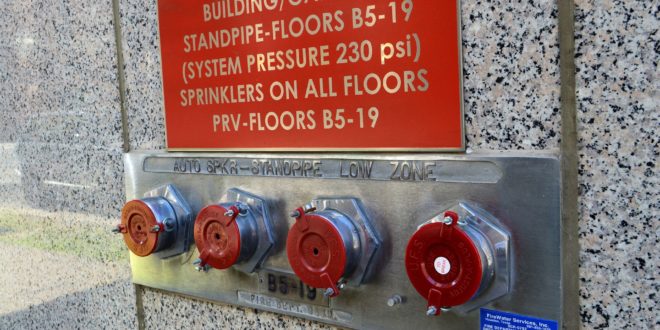
Standpipes: Protecting Horizontal Pipe
What are Laterals?
One of the aspects of NFPA 14, Standard for the Installation of Standpipe and Hose Systems, that has been regularly edited over the last several cycles of the standard is the protection of piping against fire damage. This article will look at these changes with a particular focus on laterals. It will also limit the discussion to Class I standpipes.
The reason for this article is that although NFPA 14 is in pretty good shape, the driving force—that being the International Building Code (IBC)—is not yet as well defined. Let’s start with the portion of the IBC that addresses protection of the pipe. Section 905.4.1 states: “Protection. Risers and laterals of Class I standpipe systems not located within an interior exit stairway shall be protected by a degree of fire resistance equal to that required for vertical enclosures in the building in which they are located.” There’s then an exception that states: “In buildings equipped throughout with an approved automatic sprinkler system, laterals that are not located within an interior exit stairway are not required to be enclosed within fire-resistance-rated construction.” Seems simple enough except there’s no definition for lateral. IBC also directs us when no definitions are provided to do as follows: “ … such terms shall have ordinarily accepted meanings such as the context implies… ” This is the same guidance provided by the NFPA standards except they take an additional step and state: “Merriam-Webster’s Collegiate Dictionary, 11th edition, shall be the source for the ordinarily accepted meaning.” In checking Merriam-Webster, we’re told that a lateral means “a branch from the main part (as in an irrigation or electrical system).” This seems to support the text in the IBC commentary (the equivalent to the Sprinkler Handbook for NFPA 13) that define laterals as “ … and laterals (i.e., the horizontal segments of standpipe system piping)… ” The problem, though, is that the definition states that it’s a pipe section from the main part (aka the standpipe) and parts of the system go to the main part such as feed mains. Before diving this deep into the nuances of the English language (which we code nerds are supposed to do), keep in mind that for many years the feed main was not required to be protected. Even more of a problem is that historically NFPA 14 had a specific use for the term lateral. So, let’s now delve into the history of NFPA 14 regarding the protection of piping and this thing called a lateral.
In the 1978 edition of NFPA 14 (13 cycles or 41 years ago), all it said was: “3-3.2 Standpipes shall be so located that they are protected against mechanical and fire damage.” No guidance is given on what that applies to or how to accomplish it. Other interesting items are you could have a single standpipe in smaller buildings (the driving criteria was “… that all portions of the building are within 30 ft of the nozzle when attached to not more than a 100 ft hose”), the minimum pressure for a Class I system was 65 psi, and locating the standpipe in the exit stairway was a recommendation in the annex. The body of the standard simply says to place the hose station so it is conspicuous and not likely to be obstructed. The only use of lateral was in the annex for this section where it stated: “A-4-1.1 Hose may be located at one side of the standpipe and supplied by short lateral connections to the standpipe where necessary to avoid obstructions.” In other words, it’s in the immediate area of the standpipe.
Let’s jump 18 years to the 1996 edition of NFPA 14. We’re now in more familiar country. There’s the placement within all required stairways (though it is interesting that the same annex material from the 1978 edition remains, saying they should be in stairways) along with adjacent to openings in horizontal exits. There’s also the now common 100 psi minimum pressure. Surprisingly, the 100-ft hose and 30-ft throw criterion is gone, having been replaced with a travel distance (though it lives on in the IBC so you must still be aware of it—but that’s a design issue). Feed mains (defined as: “that portion of standpipe system that supplies water to one or more standpipes”) and branch lines (defined as “a piping system, generally in a horizontal plane, connecting one or more hose connections with a standpipe”) have also been explicitly identified. It’s worth noting that branch line started as feeding more than one hose connection. More pertinent to the focus of this article is that explicit guidance on protection is provided. Section 4-1.2.2. states: “Standpipes and lateral piping SUPPLIED BY standpipes shall be located in enclosed exit stairways or shall be protected by a degree of fire resistance equal to that required for enclosed exit stairways in the building in which they are located.”
This requires just the standpipe (aka vertical risers) and the horizontal feeds to hose connections (as indicated by the capitalized phrase “supplied by”) to be protected. It’s interesting to note that this section did not use the new term branch line. There is also an exception when the building is sprinklered that lateral piping to 21/2-in. hose connections is not required to be protected. Allow me to emphasize that the feed main is not part of the system that required protection. Additionally, we now have two uses of the phrase lateral, as in lateral piping to hose connections and lateral connections to avoid obstructions.
The 2003 edition (as well as the 2007 edition) had the same protection requirements as the 1996 edition as well as the same use of the phrase lateral. There were two related items that did change. First off, the definition of standpipe heretofore just in the vertical orientation added that it can also refer to portions of horizontal pipe that are supplying two or more hose connections on the same level. Secondly, branch line was changed to its current usage of serving no more than one hose connection (obviously in response to the change to standpipe).
The 2010 edition is when things finally were comprehensively addressed. Instead of saying just standpipes and lateral piping supplied by the standpipe, it covers all piping with section 6.1.2.2 stating: “Feed mains, standpipes, horizontal standpipes, and branch lines supplied by standpipes shall be… ” (the rest of the paragraph is the same). Finally, feed mains were required to be protected. The term branch line was also finally used in place of lateral piping supplied by the standpipe (confirming this was indeed the intent of the phrase lateral piping). This now reduced the use of the term lateral only to the annex where it says lateral connections.
In the 2013 edition, although barely worth mentioning, the only change of note relates to the use of lateral. A new section 7.10.1.1.6* states: “Where lateral piping serves a single outlet, the minimum flow rate for the system shall be determined as if the outlet is being served from a separate standpipe.” There is also new annex material and an associated figure where lateral is used another four times. I’m not sure why they reverted to the old phrase instead of saying branch line, but they did. As a design side note, this is a noteworthy clarification telling us that the hydraulic calculations can have 750 gpm in a single vertical standpipe.
Let’s now take the final look at changes that occurred in the 2016 edition (that includes the 2019 edition as well since the issues of interest remained the same). There was a rather significant expansion of variables affecting when and where protection shall be provided. The first variable is whether or not the building is a high-rise. The second one is the type of construction per the IBC (such as Class I). The long-standing variable of whether or not the building is sprinklered was retained. These variables are then applied to three different pipe groupings; these being standpipe, horizontal, and branch line. There is a note that horizontal means a horizontal standpipe or horizontal portions of any standpipe such as feed mains. We can take this to mean all other horizontal pipe except for branch lines since that is individually listed. Fortunately, this is nicely presented as table 6.1.2.2. An outcome of having building specific criteria is that in non-high-rise buildings, we are back to no longer protecting the feed main or any other horizontal pipe (including branch lines) even when the building is not sprinklered. There is one other useful change whereby one can now use listed fire wrap applied directly to the pipe. It’s interesting, though, that the hanger assembly doesn’t have to be protected. The use of the phrase lateral remained the same as the 2013 edition.
So, what needs to be protected and when? More importantly, do we have a conflict between the IBC and NFPA 14? Unfortunately, the answer is yes. Let’s start with where and when to protect the pipe. The bad news is that it is ambiguous in using laterals as a noun (and that it isn’t defined). This implies that all horizontal pipe is protected. More bad news is that the commentary to the IBC leaps to this non-supported conclusion. This matches the criteria of the 2013 edition of NFPA 14. Let’s shift the discussion to the term laterals (that clearly is an outdated term) so as to better define what is the likely intent. NFPA 14 uses lateral as an adjective describing applicable nouns as in lateral piping and lateral connection. As far back as 1978 it used lateral connections as short sections of pipe in the immediate vicinity of the standpipe where the hose connection is not connected immediately on the standpipe (so to make it more accessible). The more extensively used phrase of lateral piping supplied by the standpipe has always been understood to mean to a hose connection outside the stairway. It has been used within the industry as a noun where we say the lateral to the hose connection. Its use in this fashion was mostly converted to the term branch line. It was definitely clear enough to show this was indeed its common use definition. As such, the literal requirement for protection by the IBC applies only to branch lines and not feed mains. Such a literal application is not a good idea for all cases but is critical for any discussion on what is actually required. Keep in mind that NFPA 14 did not require the protection of feed mains until the 2010 edition. There were two NFPA 14 editions that required all horizontal pipe to be protected. That changed with the two latest editions having appropriately included the type of construction on dictating when to protect horizontal pipe. A final item that could also create an interpretation issue is how to protect the pipe. The IBC starts by saying a certain degree of fire resistance is required for protection. It then states in the exception allowing no protection when the building is sprinklered, that the pipe is not required to be enclosed in fire-rated construction. This strongly implies that the base requirement is meaning construction (also the commonly understood means to provide the protection). The issue is that NFPA 14 now allows the fire-rated requirement to be accomplished using a listed fire wrap or other insulating material. In reality, this last one is simply a means for the contractor to do something when the engineer of record misses addressing it in the initial building permit phase.
In conclusion, although there are currently some conflicts, they, fortunately, should be readily resolvable since it appears the IBC is simply stuck in the 2013 edition of NFPA 14. The fact that there has been some very reasonable evolution over the last two editions of NFPA 14 should be viewed by all as desirable. It also helps that the conflicts do not appear to be intentionally different (like with NFPA 13R, Standard for the Installation of Sprinkler Systems in Low-Rise Residential Occupancies, and balconies before the 2013 edition). If you’re responsible for addressing the issue of protection of the standpipe piping or attempting to define a process on how your company will treat it, ensure you have a discussion with the applicable Authorities Having Jurisdiction (AHJs).

ABOUT THE AUTHOR: Roland J. Huggins, PE is the senior vice president of engineering and technical services for the American Fire Sprinkler Association (AFSA). He is a graduate of the University of Maryland and registered in Fire Protection Engineering. He is a member of the National Fire Protection Association (NFPA). Huggins has served on the NFPA Standards Council and is a member of multiple NFPA technical committees, including NFPA 13 Correlating Committee, NFPA 13 Discharge Criteria, and NFPA 5000 (Building Code) Correlating Committee. NFPA activities have included participating in the editing of the Sprinkler Handbook and the Fire Protection Handbook. Other national activities involve the NFPA Research Foundation, UL Standard Technical Panels, and NICET. He has conducted many seminars and presentations as well as written numerous sprinkler-related articles. Huggins is a veteran.
IMPORTANT NOTICE: The article and its content is not a Formal Interpretation issued pursuant to NFPA Regulations. Any opinion expressed is the personal opinion of the author and presenter and does not necessarily present the official position of the NFPA and its Technical Committee.

 Sprinkler Age A Publication of the American Fire Sprinkler Association
Sprinkler Age A Publication of the American Fire Sprinkler Association
